Signalis is an old-school style horror adventure game where robot clone girls try to find their friends amidst a zombie-like outbreak. It’s a lot. It makes sense, then, that the conclusion(s) are also a lot. This long essay-guide is my attempt at explaining the ending of Signalis. Buckle up.
Obviously, complete and total spoilers below for Signalis. Gorgeous cover art above is by @NeonMirrors.
The Smoking Gun of Signalis: The Photo
To explain the ending of Signalis, we start at the beginning. You play as Elster, a robot clone, who wakes up in a crashed spaceship on an exploration mission for a fascist society. She was the Penrose 512’s mechanic; her only goal now is to find the ship’s pilot, Ariane Yeong. Elster discovers this photograph hanging on the dashboard:

This photo is key to understanding Signalis. The prologue ends with Elster using a code on the back of the photo to exit the spaceship and explore a white, snowy landscape. She finds shelter in that strange bunker. Upon touching the flashing walls, Elster’s vision flashes through a variety of images, including the words in red: REMEMBER OUR PROMISE.
Elster blinks awake in the bathrooms of Sierpinski, and the photo, still in Elster’s inventory, has changed.
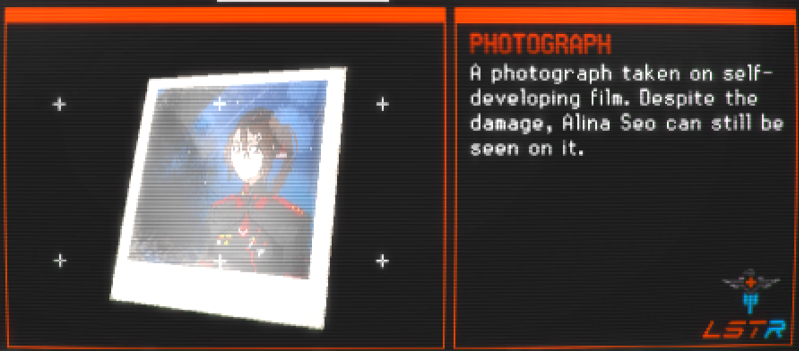
It is now a brown-haired woman named Alina Seo. For me, and perhaps it was for you as well, this was the moment where I was like, “Aw yeah, this game is gonna be WEIRD.”
Let’s skip to the ending so we can get into it.
The Multiple Endings of Signalis
When I first “finished” Signalis, I was confused and immediately went online to search for answers, only to realize I had gotten faked out hard by a false ending.
Yuri Stern, one of the two members of developer rose-engine, told Waypoint, “To be honest, I didn’t expect many players to even reach that ending. It’s a bit of a strange habit perhaps, but I don’t finish most of the games I play, even the ones I enjoy a lot. So in a way, that ending was my way of trying to make sure people like me get to see an ending even if they usually don’t finish games. That way, they can stop if they’ve had enough.”
Realizing there was more, I knew I had to return to finish Signalis.
After the fake-out, there are three core endings determined by your playstyle, and a secret epilogue achieved with a lot of replay work. You can (re)watch them all here.
I personally got the “Promise” ending where Elster finds, says goodbye to, and kills the aforementioned Ariane.
The player discovers over the course of the game that Elster and Ariane had been the only two living creatures aboard the Penrose 512. Despite strict rules against fraternization of any kind, Elster and Ariane had become friends, and then lovers. During their lonely mission, made a promise to kill each other rather than suffer and die alone. It’s all heartbreaking.

Throughout the decayed spaceship, Elster finds other LSTR bodies. I read the multiple endings to be sort of showcasing the journey of other Elsters (and almost as a stand-in for other players, though the game isn’t online at all) and whether they were able to succeed or not.
The other half of rose-engine, Barbara Wittmann, shared in the same interview, “Endings are determined based on the players’ overall playstyle. It was not our intention that players replay the game to try to get another ending. Rather, we wanted for each player to get an ending that fits their playstyle.
The ending of Signalis, explained
Signalis, I believe, takes place in an elaborate dreamscape created by a sick and dying Ariane Yeong in the hopes of being reunited with her love, Elster, an LSTR unit that has long since perished.
Ariane builds a dream upon a dream, desperately trying to make her hopes into a reality. Ariane and Elster had promised to kill each other, rather than slowly die alone, but Elster’s mechanical body gave out earlier.
Through the course of the story and in-game lore, we can start to identify a few things that we “know” to be true, one of which is that Ariane Yeong was accepted into a space exploration mission called the Penrose Program.

The Penrose sends one human and one robot–in this case, Ariane and LSTR (our particular unit, the protagonist, is nicknamed “Elster”)–in a ship each to the far ends of the universe to look for hospitable planets to settle. Operation Penrose warns its soldiers that there is a high likelihood of failure. When they don’t find a planet by a certain timeline, Ariane receives guidance from their government that encourages the human to accept a swift death. But she doesn’t.
Why Ariane Creates the Signalis Dream
Ariane Yeong is a bit of a rebel. She paints. She fiddles with the radio. She grew up with her mother, rather than raised by the state. She doesn’t drink the political Kool-Aid without question. The player can find sealed “CONFIDENTIAL, READ NOW — for pilot’s eyes only” documents that Ariane has never opened that tell the human pilots to not befriend their robot companions or to let them see war movies, lest it trigger latent negative Gestalt memories.
From comments that Elster makes and of the three core endings above, we discover that Ariane did not accept the swift death. She rests partially in a cryo-chamber. The player can find diary records that mention that she is sick. Elster remembers succumbing to her own decay of robotic programming. It seems that Ariane either put herself in a state of prolonged temporary death, or that Elster “IRL” did it. In the past, they had promised to kill each other rather than let them live in pain and alone. But Ariane is stuck, not dead but no longer fully alive.
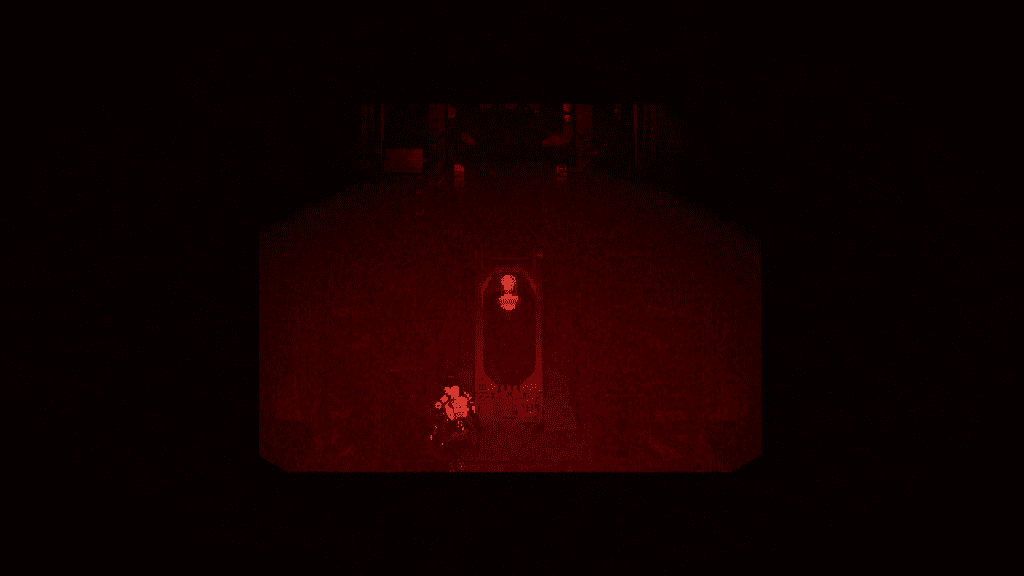
In her sickness and indefinite trap, Ariane imagines how things could’ve been different. But she is not a normal person — she has high bioresonance, and she creates a fully fleshed out dream world over which she is god.
The “Promise” ending of Signalis allows Elster to finally be able to free both of them from unending suffering. To me, it felt it was “the right/true ending,” though I imagine your opinion on the Signalis ending changes depending on your personal value systems around love and loss. However, the final cutscene you watch is only the beginning of trying to understand Signalis.
How do we know Signalis is “a dream?” Because of Ariane’s bioresonance
We know from in-game documents this universe is shaped by bioresonance. The player can find the banned book, “Song of the Gods,” which explains:
“There exists a connection between all of us that few are fully aware of. A song that we all dance to, but few can hear…. Every once in a while, some are born that cannot only hear and play this music of the worlds, but who can conduct it. Gifted individuals capable of manipulating the essence of the world around them.”
An Imperial Spy met Ariane when she worked at the photoshop, and he describes being terrified of her astounding bioresonant abilities that she doesn’t even seem to be aware of. This knowledge casts the game’s ending in a different light — perhaps Ariane doesn’t even fully know what she’s doing.

Sick, sad, and alone, Ariane creates a repeating time loop in a false reality. Imagine being hyped up on Dayquil — you’re delirious and feel terrible, and you aren’t thinking clearly. You do things you might not normally otherwise do, like binge ten hours of a television show or eat chicken soup for three meals in a row or send emails you definitely shouldn’t be sending. Ariane’s lonely, diseased daydreams build a nightmarish reality.
Sick, sad, and alone, Ariane creates a repeating time loop in a false reality.
The Relationship Between Ariane Yeong & Alina Seo in Signalis
For me, one of the defining pieces of evidence of the “dream” reading of the Signalis ending is that photo from the very beginning of the game.
If Elster keeps this photo in her pocket, she can show it to the few other un-corrupted souls and ask them if they’ve seen Alina. She later finds Alina’s worker key. Over the course of the game, Elster finds diaries of Alina’s who mentions confused memories, such as remembering Elster even though there has never been an Elster assigned to Sierpinski.
Eventually, we learn that Ariane Yeong and Alina Seo met “IRL” briefly on the planet Rotfort. Ariane worked at the family business, Yeong Photo, and developed some images for Alina, a traveling soldier. Ariane and her aunt discussed how similar Ariane and Alina look. One photo in particular showcases Alina with another soldier who has lost an eye, which I’ll get back to momentarily.

In flashbacks, we learn how Ariane was bullied violently by other students at Rotfront for being an outcast. Her friend, Isa, witnessed the torment but was too afraid to intervene. Iso’s twin, Erika, later intervened. In other documents, we learn how Ariane had requested being assigned the exploratory Penrose mission and if not that, then to be a soldier.
I take this to showcase how Ariane admired Alina’s bravery, sense of adventure, and friendship.

Furthermore, all the robotic clone brands are based on individual real-people known as Gestalt (the German word for “shape” or “form”). The LSTR line of machines, of which Elster is one, is based on a soldier from the planet Vineta.
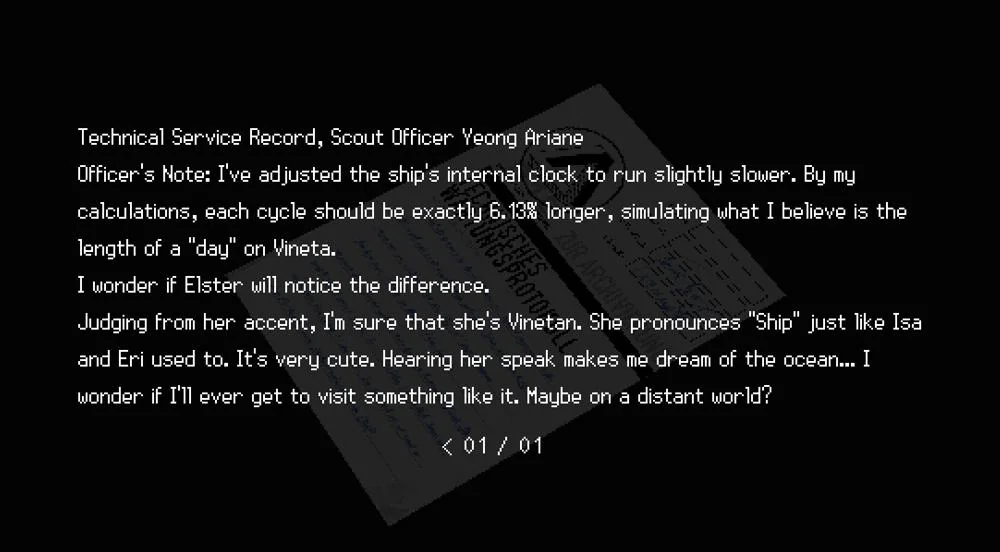
By exploring in-game lore, we can draw the conclusion that Elster’s Gestalt was the Vinetan with the missing eye in the photo with Alina, further complicating their representative relationships in the dream-space.
If you want to take it even a step further, there are strong arguments that this other soldier is Lilith Itou. If that last name sounds familiar, it’s because she was the mother of Ariane’s friends Isa and Erika. Connections upon connections for the Ariane Yeong <> Alina Seo mental overlap. It would make sense, in this dreamspace, for “Lilth” (Elster) to be looking for her friend Alina (a stand-in for Ariane).
Yes. It’s a lot.
A Timeloop in a Dream
Remember our fake-out ending? It is another significant clue that the player hasn’t begun to understand what is really going on. Adler begs Elster not to go out there, that she’ll “destroy everything.” Adler informs her they’ve been here before, but never like this. We know not only that we’re in a time loop, but that we are helping Elster break the cycle.
If the game is continued from here, we see Ariane “fade in” over Elster’s dead body. (To watch, check out this video at the linked timestamp of 4:59:34; screenshot below) To me, this is proof that the game is in a dream, as we know Ariane can no longer stand. This is her, as the Dreamer, choosing to continue the dream.

When Elster wakes up from her supposed death, she is back on Penrose 512, her spaceship. She pulls off an arm from a previous version of herself, and welds it to her body. We repeat some of the beginning puzzles from the game, though in an even creepier and run-down version of the ship. When she goes to the cryo-chamber this time, it’s a pulsing mass of flesh, similar to the Nowhere section of the game.
The architecture of the dreamworld is falling apart. The other characters are decaying. Isa disintegrates, leaving behind a shadowy mass that an in-game document explains is what happens when Gestalts are destroyed by the mysterious disease. Adler looks grotesque, his skin coverings falling off. He laments, leaning over Falke’s motionless body, that it’s as if “everything was taken apart.” Time is taking a toll on Ariane’s creation.

Dream Logic
Once we can reframe the entire game by being in an active dream landscape (kind of like Inception), then a lot of things make more sense. Elster travels across wide, unconnected locations. These range from Ariane’s childhood home at the radio tower to Rotfort where she went to school (with each room that had an impact on Ariane being taken over by bulbous fleshy organs) and a grotesque pit that seems to be at the end of the known universe. At one point, she crawls through a tiny hole in the wall to end up in Ariane’s high school home. We’re jumping through space and time in a way that should be impossible.
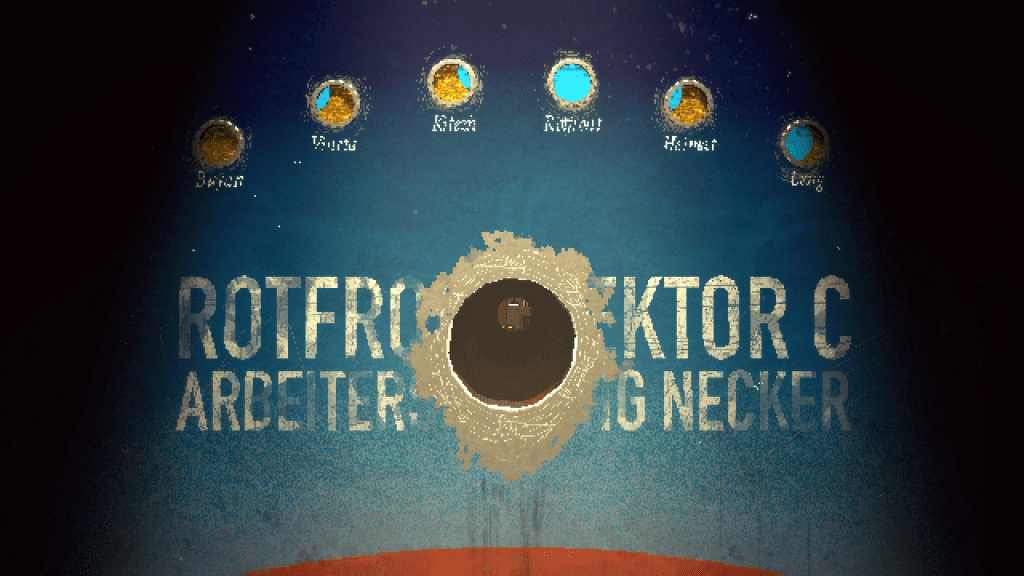
Furthermore, Isa succumbs to the sickness and admits that her sister Erika was probably always gone. When Isa dies, everything melts out of her like ink pouring from a vase, and her body disappears. If Elster inspects the shelf, she sees what appears to be two memorial photos of Isa and Erika. This sequence implies that perhaps the twins have been dead for a long time. Again… dream logic folding time/temporalities.
Lastly, in dreams, our mind may transpose some people “over” others to represent something else. Alina Seo is a soldier that had a resemblance to Ariane Yeong; they only met in passing at the Yeong photoshop. The dream state overlaps the two, allowing a version of Ariane to have lived a life in community with a strong and healthy body. (Hospital records show Ariane was often sickly.)
Commander Falke and the Red Eye
Some time before the events of the game, the Commander of Sierpinski, a Falke unit, went out into the great beyond. She discovered the truth, that she and everyone else she knew were part of a fake dream reality. Unable to cope with this reality, the Commander has a mental breakdown. Given that she is the leader and a strong bioresonant, her loss of self affected the entire compound. She told Adler that she had seen the great red eye.
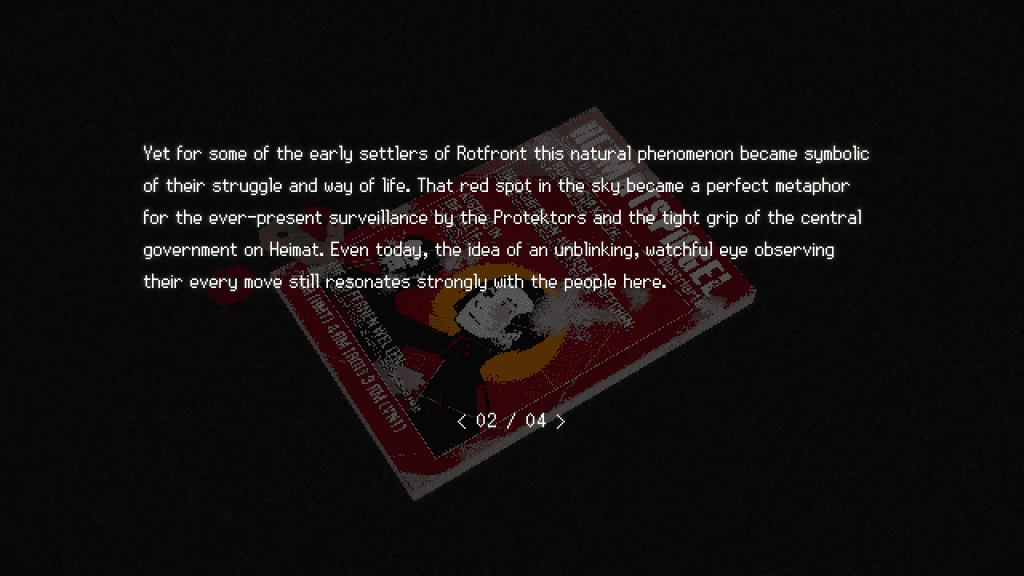
The red eye appears in-game multiple times, first in a document explaining a political propaganda response to a planet phenomena. Later, the Commander writes in her journal that she has seen it and been seen by it. In the secret ending, we see the red eye hanging high in the sky. Ariane is one of the only characters in the game to have red eyes, and given the secret ending’s spooky ritual, I think it is an allusion that this reality is under the dominion of Ariane.

In the game’s later levels, Falke appears to become another Ariane-stand-in, which makes sense as again, this is Ariane’s world. Notes from Falke indicate that she has “become one” with Ariane. Falke even laments to Elster that “she will never dance with us again.”
Additionally, in the pulsing body levels, we can find the Dreamer’s room, which is stylized just like Falke’s room, who now is in a perma-slumber with her knowledge of the truth.
Adler and the Other LSTRs
Falke’s #2 is Adler, the only male-appearing robot clone. He appears throughout the game, judging, staring, pushing, and stabbing. He speaks with cruelty and without much detail, until just before the fake-out ending. Adler begs Elster to not be selfish, to not go any further, to not ruin it for “everyone.” He claims that they’ve done “this” before; he tells her she should not have returned.
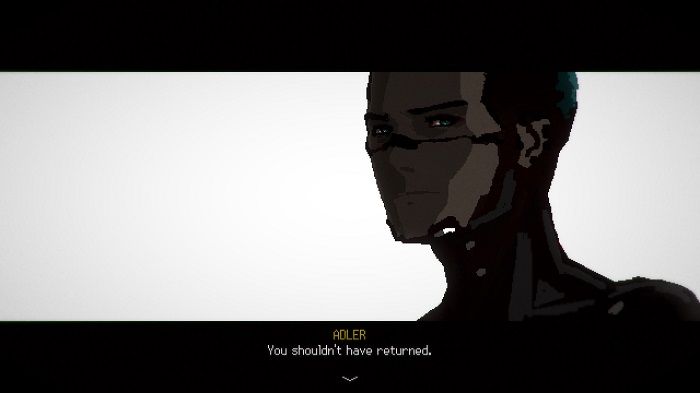
At one point in the game, Adler pushes Elster down an elevator shaft. When she awakes, she is surrounded by dozens of other LSTR frames. Redditors estimate it to be around 75 bodies, so they’ve done “this” at least 75 times.
The player can discover Adler’s diaries. His journal reveals that he is learning he has been living the same day over and over again. Each diary entry becomes more and more panicked as he realizes what is happening. In times of doubt, he turns to his structured nature and the commands of his country.
As second-in-command, with his beloved chief no longer accessible, Adler takes it upon himself to protect the only reality he knows. Adler and the other clones he knows only exist in the dreamstate. Either he has sentience or he is sort of a security measure that Ariane’s mind is putting into place to stop Elster from breaking the loop.
The Repetition of the Missing Eye
Many characters in the course of the game have one eye stabbed out — Adler, Isa, Elster herself, and in a photo, the Gestalt believed to be Elster’s base.
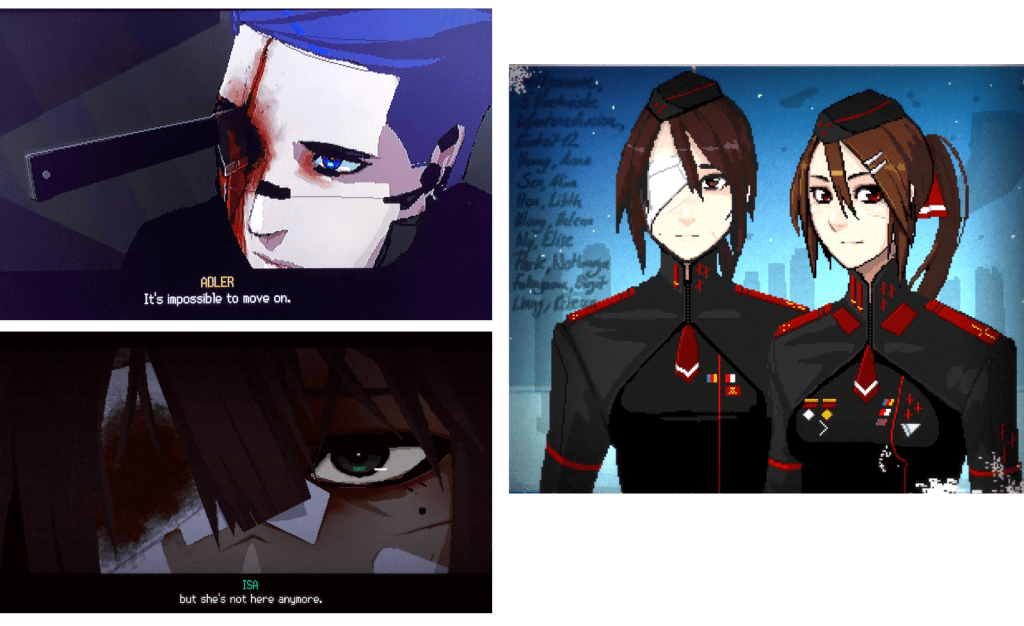
Eyes represent vision, understanding, clarity, perspective. The loss of the eye symbolizes a warped perspective of the world. Plus, its repetition across multiple characters alludes again to the circular nature of recurring dreams, and showcases how all these memories are tied together for Ariane.
Using Asset Analysis to Compare
There are a few Reddit theories that focus particularly on the art visual assets used as a point of comparison between characters to make sense of this all. User Sinobis writes:
“But after looking into the image assets dump, Alina’s Sierpinski work pass photo (which presumably would have been taken before Falke got sick and the chaos set in), and Ariane in the cryopod at the end, have bandages in pretty much the exact same locations. This lends credence to the theory that Sierpinski Alina is just the self-insert of Ariane, dreaming of a possible world where she didn’t get into the Penrose program, and Alina’s transformation back to Ariane is her waking up from the dream.”

However, another Reddit thread (which I unfortunately cannot find again) compared the character models for each character, illustrating that most of the face structures are pretty similar. The user made the practical point that the game is made by very few people, and encouraged other users not to read into the art too much because the variations were probably kept simple to reduce the workload.
The Island Paintings in Signalis
Throughout the latter half of Signalis, Elster comes across repeated and varied imagery of an island. I understood the island to be a metaphor for a place of freedom, away from oppression and authoritarian control.

The different styles showcase how Ariane has been painting the island over and over again, dreaming and hoping for a world beyond the one she knows. She is obsessive.Her mind cannot help bring this vision to the forefront over and over again. She never seems to fully finish the paintings, and the art becomes a vehicle yet again for unactualized dreams and lost love.
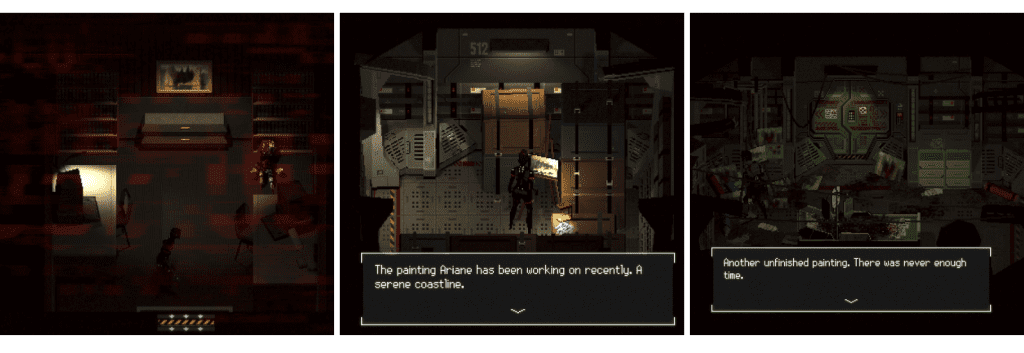
Late in the game, Elster even awakes on what appears to be a realized version of the island but it is dark and lonely, and scattered with melancholic, mysterious notes. Ariane has never been to an ocean, though she wants to, and thus it will be a place of non-fulfillment.
The main image of the island is a beautiful oil painting, and I assume is in the public domain based on its heavy use. It is “Isle of the Dead” 1880 by Arnold Böcklin which depicts an oarsman (or woman), a figure illuminated in a white shroud, and a coffin.
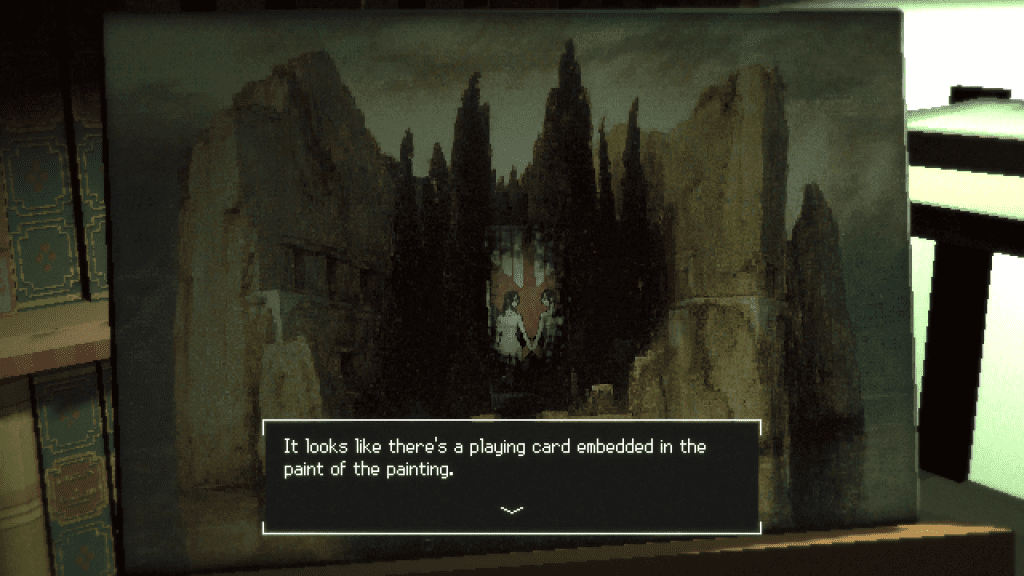
In the late game, a copy of this painting sits in the room where Ariane lived as a teenager accompanied by a tarot card, The Lovers, embedded within. We know that Ariane was a dreamer; she wanted to go on a romantic mission, far away from the world she knew, with someone special. And in the end, she did.
The Creators of Signalis on the Dream Theory
As in dreams and dream analysis, returning to the source is recommended. In the previously mentioned Waypoint interview, Yuri Stern reflected, “SIGNALIS went through many iterations. I always felt a strong urge for the story to have a dream-like quality, but often felt things ended up feeling a little too banal, so I’d reflect on what my dreams feel like and applied that to the way we told the story.”
Barbara Wittmann shared in an interview with Bloody Disgusting, “One theme of the game is the feeling of ‘otherness,’ and not fitting into an authoritarian society… it also combines themes that we were both really excited and passionate about, like dreams, androids, horror, and retro-tech sci-fi.”
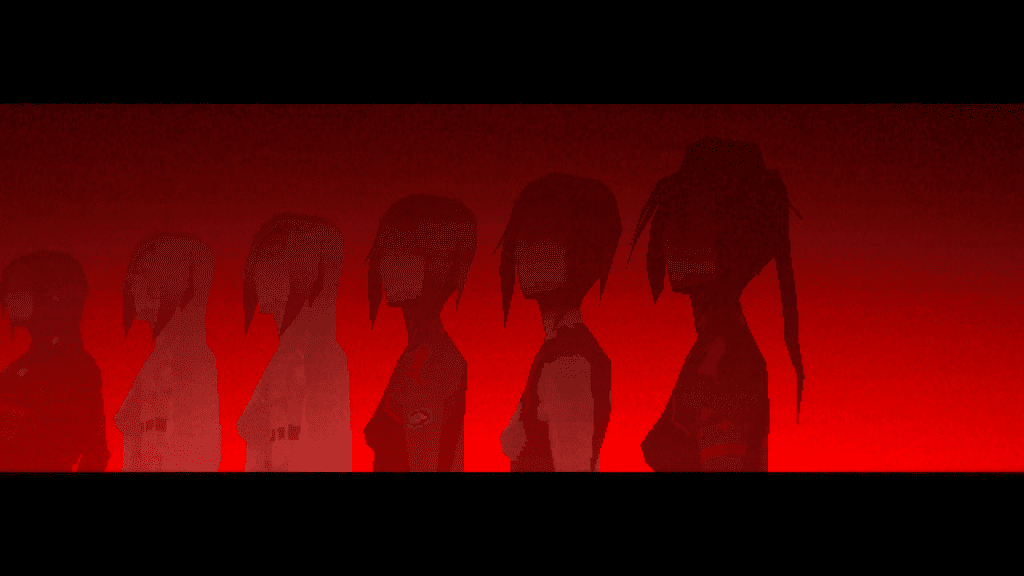
In summary…
The Elster we know is a figment of Ariane’s deep subconscious.
Within the dream reality, Elster is searching for her lost love. When she finally finds her, Elster will take some kind of action. I am inclined to read the “Promise” reading as “the best” as it allows Elster to fulfill her promise to kill Aliana and to finally free her, and all the rest of them, from their loop. After killing Ariane, Elster dies beside her lover.
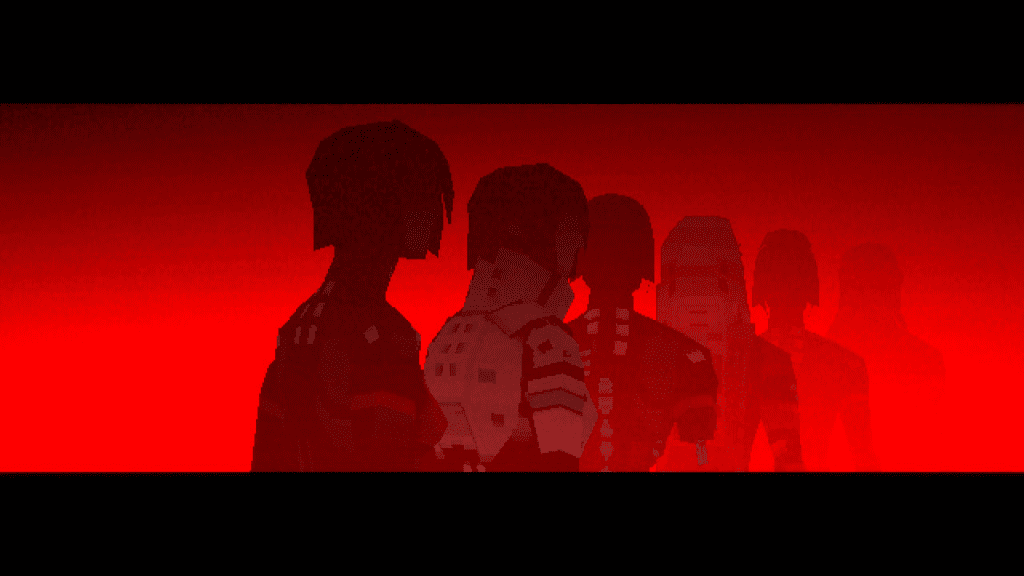
In the secret ending, the ritual features multiple LSTR units placing objects that were important to Ariane on pedestals, sort of as a sacrifice. The LSTRs then apparently die, and the camera shifts up to the red eye, before cutting a black-and-white “replay” of Elster and Ariane dancing together in the spaceship that slowly fades.
I read the secret ending of Signalis to be about the acceptance of their deaths, but together, and that it is a memory that both choose to relive and remember together in their dying moments.
What is Signalis about?
I think Signalis considers who we are when it really matters through the lens of an ostensibly a robot horror survival story. When we find ourselves at the precipice of a big decision, what will we choose? How will we act? Will we stand up for our friends against bullies? Can we be brave enough to let loved ones go? Will we choose to hide in our memories and live in the past, or, despite the pain and struggles, brave forward into the unknown?
Signalis reminds me of the famous line by Lord Alfred Tennyson, “Tis better to have loved and lost than never to have loved at all.” I think developers rose-engine seem to agree.

Signalis reminds me of the famous line by Lord Alfred Tennyson, “Tis better to have loved and lost than never to have loved at all.” I think developers rose-engine seem to agree.
I actually have no idea if I’m right. Maybe that’s the point?
These are, at the end of the day, just my theories. Shortly before publishing this piece, I read a Reddit theory by @TheMightyNovac which details a much more literal spaceship crash-landing take that was so valid I almost didn’t bother with this.
The Signalis lore is so rich and the endings so vague that it has spawned a loving, obsessive community on its subreddit. People are still talking about Signalis nine months after its release, and perhaps that can only be achieved when answers cannot be found.
As far as I can tell, there’s no “official” ending to Signalis. The creators, two-person studio rose-engine, have been very tight-lipped about the endings. So far, they’ve only said that they feel there are “no good or bad endings” and for the game to be read as an exploration of “otherness.”
If you’ve played Signalis, do you agree with my round-up of theories? What did I miss? Someone please help me understand this game. Even the Signalis Wiki just has whole sections per page called “Theories.” Let me know in the comments what the hell is going on.
We’re all just trying to make sense of this incredibly emo and spooky love story, aka life.
Signalis was released on October 27, 2022, by rose-engine. It is available on Nintendo Switch, PlayStation 4, Xbox One, Microsoft Windows, and Xbox Series X and Series S.
Amanda Tien (she/her or they) loves video games where she can pet dogs, punch bad guys, make friends, and have a good cry. She started writing for the site in 2020, and became an editor in 2022. She enjoys writing about mystery games, indies, and strong femme protagonists.
Her work has also been published in Unwinnable Monthly (click here to read her cover feature on Nancy Drew games), Salt Hill Journal, Poets.org, Litro Magazine, Public Books, and more. She was the Co-Founder and Editor-in-Chief of Columbia University's Culinarian Magazine, and served for two years as the Managing Editor of Aster(ix) Literary Journal.
She recently graduated with a MFA (Master of Fine Arts) in Creative Writing from the University of Pittsburgh. Her writing, art, graphic design, and marketing work can be viewed at www.amandatien.com.
She does not post a lot on social, but you can find her on X and on Instagram.










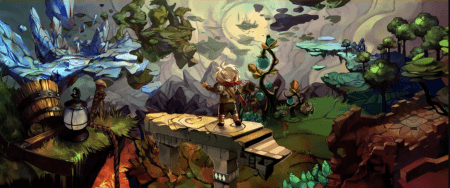

4 Comments
A *communist* society.
That you, Vance?
Well written article, certainly a very detailed dive into the confusing aspects of the game.
WOW I just finished this game and watched all the other endings (mine was memory). And then I read your article and everything now makes total sense!
I do kinda agree with the reddit post you link where it might be literal, but honestly I don’t buy it because of the wacky tunnel you can fit in at the end and Adler memory not being erased when the cycle repeats. So honestly I think you got it on the mark.
That one part where you wrote Alina Seo’s partner was Lilith Itou which makes Elster being a copied version of Ariane’s friends’ mother was freaky. Which take me off guard because Ariane’s a MILF hunter for dating a pseudo version of her friends’ mother LOL. Absolute Cinema.
My own theory (which was quickly dispelled) was that Ariane’s bioresonance actually controls LSTRs who thinks they are Elster (basically blends the memory of other LSTRs to her Elster (because bioresonance magic!) all the way from home and make them go search for the Leng mining facility to search for Ariane (which is collapsing over time due to her bioresonance too). Also signals actually do travels in space (and the game is called signalis) so I thought that it actually did happened. And she controls the LSTRs to steal the ships to go to space for years to where she is sleeping to keep the promise. Well, this theory was full of holes so I discarded it after reading yours.
It just shows that this game was good and makes you think at the end, which I always love.
I hope the creator makes another game in the same universe. Maybe we can finally visit the planets and see other units’ pasts and stories.